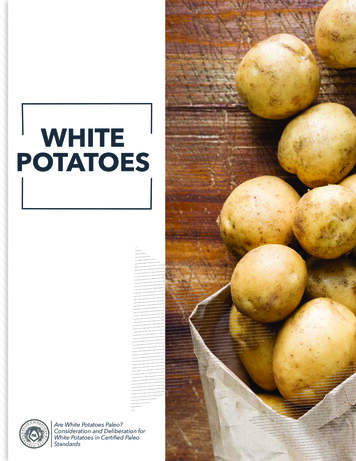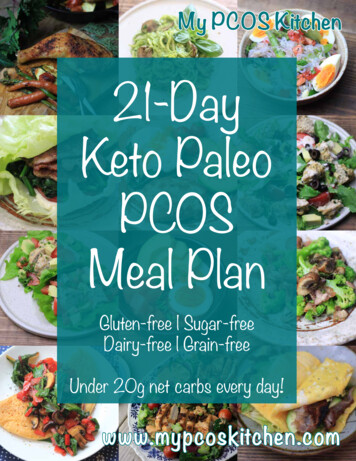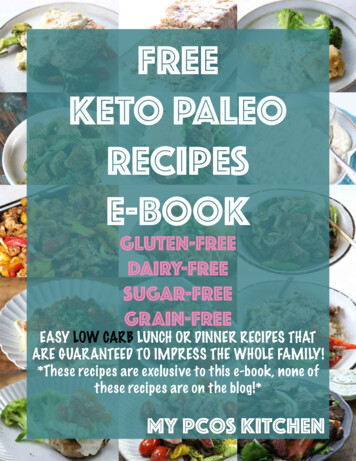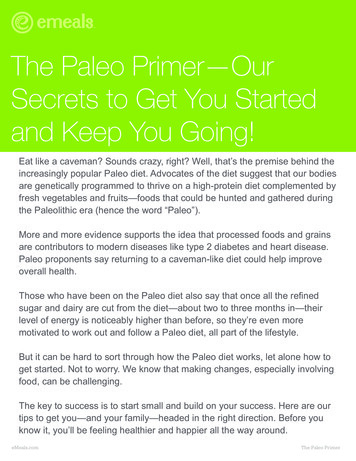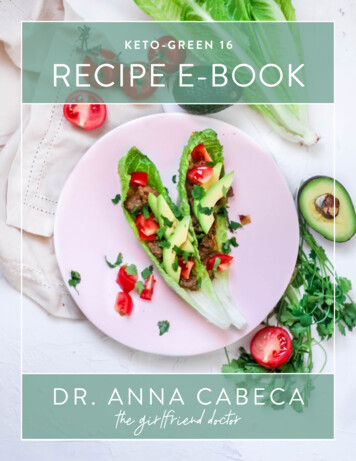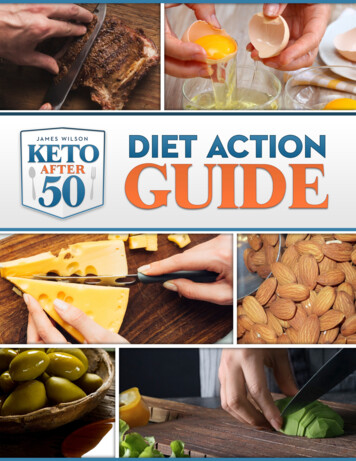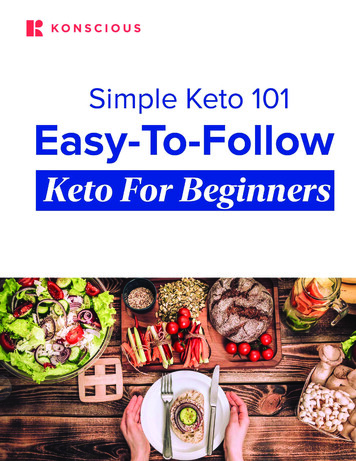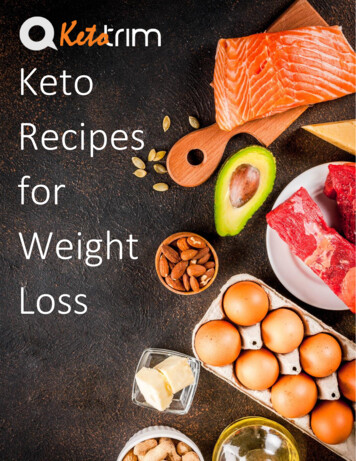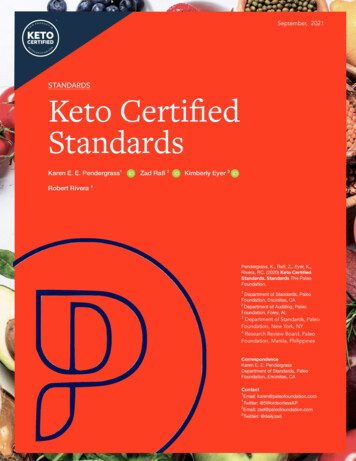
Transcription
September, 2021STANDARDSKeto CertifiedStandardsKaren E. E. Pendergrass1 Zad Rafi 2 Kimberly Eyer 3Robert Rivera 4Pendergrass, K., Rafi, Z., Eyer, K.,Rivera, RC. (2020) Keto CertifiedStandards. Standards The PaleoFoundation.11Department of Standards, PaleoFoundation, Encinitas, CA2Department of Auditing, PaleoFoundation, Foley, AL23Department of Standards, PaleoFoundation, New York, NY4Research Review Board, PaleoFoundation, Manila, Philippines34CorrespondenceKaren E. E. PendergrassDepartment of Standards, PaleoFoundation, Encinitas, CAContact1Email: karen@paleofoundation.com1Twitter: @5WordsorlessKP2Email: zad@paleofoundation.com2Twitterl: @dailyzad
Table of ContentsKETO CERTIFIED STANDARDS 2021IntroductionStatement of PurposeMajor factors influencing TolerabilityStandards & Development345StandardsKeto Certified labelApplicabilityGuidelinesUse of the Keto Certified labelCarbohydrate ContentPrebiotic fiberAllowed ingredientsApplicability of exogenous ketonesDisallowed ingredients66789111213132
Statement of PurposeWhen The Ketogenic Diet was finally standardized in 1925 by Dr. Peterman [1] , itwas strict in its requirements; 1g of protein per kilogram of bodyweight, 10-15grams of carbs per day, fill the rest of the remaining calories with fat.Unfortunately, Dr. Peterman didn’t make any specific requirements about wherethe carbohydrates could come from, or what foods should have been allowed orrestricted in the ketogenic diet, leaving much open for speculation.While public acclaim and medical advocacy for the ketogenic diet is growing, itdid not initially become the primary therapeutic option even though it largelyeliminated the need for drugs and potential side effects. While there are manyexplanations for why this occured, one point seems clear: the ketogenic diet canbe extremely difficult for patients to adhere to, and it can cause serious adverseeffects [2].In the development of Keto Certified Standards, The Paleo Foundation includedingredients and foods that serve the purpose of mitigating the most well-knownadverse effects of the Ketogenic Diet, as well as increasing its tolerability.Individual tolerability of the ketogenic diet is the most important factor for dietacceptance and adherence. Therefore, improving palatability, availability,affordability, and convenience of compliant foods is crucial to preventing dietdiscontinuation.Keto Certified products are in a unique position to improve tolerability of theketogenic diet through improving palatability, convenience, and availabilityfactors. The Keto Certified Standards and Keto Certified program are aligned withThe Paleo Foundation’s mission to help improve the tolerability of the ketogenicdiet.Karen PendergrassPaleo FoundationStandards Team CEO3
The 4 Major Factors ThatInfluence Diet TolerabilityAvailability: Product Offerings, Location and Limitationof ProductsAffordability: Socio-Economic Limitations, DistributionLimitationsPalatability: Product Variations, Ideological AcceptanceConvenience: Cultural Acceptance, Ease of Identification4
Standards & ResearchROBB WOLFResearch Biochemist,Author of The PaleoSolution, andWired to EatZAD RAFIResearch Statistician,Bachelors in NeuroscienceNYU Langone, PaleoFoundationMARK SISSONTriathlete,Author of the PrimalBlueprint, Keto ResetDietKAREN PENDERGRASSResearcher, WriterBusiness AdministrationUMKC, Founder, CEOPaleo FoundationALEX LEAFNutrition Researcher,M.S. in Nutrition, CISSN,Teaching Staff Universityof Western StatesKIMBERLY EYERBSN, RNFA, Managing Director St.John’s Abulatory Services Center ofSanta Monica, California. CFOPaleo FoundationROBERT RIVERAB.S. Food Science andTechnology. Health andFitness Writer,HACCP Certified5
Keto CertifiedProgram Standards and Specifications 20191. Keto Certified LabelThe Keto Certified requirements are outlined herein. These standards apply to all productscertified by The Paleo Foundation for the Keto Certified program. Only certified productsfollowing these standards are explicitly given the rights to use Keto Certified logos,trademarks, certification marks, or other design marks hereinafter referred to as “KetoCertified label”.1.1 ApplicabilityThe Keto Certified label was developed and trademarked by The Paleo Foundation toidentify food products that meet the standards of the ketogenic diet. The Keto Certified labelis a certification mark with use permitted only to those who have entered into a contractualagreement with the Paleo Foundation. The Keto Certified label was designed to establish aneasily identifiable mark indicating that a product has met the strictures of the ketogenic dietand merit use of the Keto Certified label.6
1.2 Guidelines1.2.1The Keto Certified label is allowed to be used on any company advertising materials,including packaging, promotional materials, point-of-purchase materials, websites, salesliterature, banners, and company stationery, provided that the use of the Keto Certified labelcomplies with the guidelines outlined in this document. If a company wishes to present thelogos in a manner other than as described as outlined in section 1.3, The Paleo Foundationmust approve the request and give written permission to the producer.1.2.2Producers may display the Keto Certified label only on products that have been certified byThe Paleo Foundation.1.2.3Producers must have a contractual agreement with The Paleo Foundation to use the KetoCertified label.1.2.4Producers may only use the trademark on company stationery if the entire product line hasbeen audited and Keto Certified.1.2.5If the entire product line has been audited and Keto Certified, producers may display the KetoCertified label on their entire website.1.2.6If the entire product line was not certified, the Keto Certified label may appear on a pagecontaining the audited and certified Keto Certified products only.1.2.7Products that have not been audited and Keto Certified are not permitted to appear on thesame page as the Keto Certified label, as this could mislead consumers.7
1.3 Use of the Keto Certified Label1.3.1To complete the application process, the applicant must sign an affidavit stating that allanswers and statements provided in their application were true to the best of theirknowledge.1.3.2Use of the Keto Certified label is only permitted after audit and certification of theapplicant’s products by The Paleo Foundation.1.3.3The Paleo Foundation retains the right to inspect the producer’s products to verify that allrequirements are met.1.3.4Use of the Keto Certified label for any product that does not meet each of the Keto Certifiedrequirements, that has not been audited, or that has not been given explicit permission, isstrictly prohibited.1.3.5Misuse of the Keto Certified Label will result in immediate suspension of the agreementand/or prosecution.1.3.7The Keto Certified label must be :⓵ Upright⓶ Complete⓷ Clearly Visible8
2. Carbohydrate ContentThe allowed carbohydrate content for the Keto Certified program is based on the USDAstandard serving size of a food product.2.0.1Meal and Meal Replacement products must not contain more than 10g net/effectivecarbohydrates per serving. For products which contain minimally processed, whole-foodingredients or ingredients with reduced digestibility, 12g net carbohydrate per serving ispermissible.2.0.2Snack products must not contain more than 6g net/effective carbohydrates per serving. Forproducts which contain minimally processed, whole-food ingredients or ingredients withreduced digestibility, 8g net carbohydrate per serving is permissible.2.0.3Condiments must not contain more than 2g net/effective carbohydrates per serving. Forproducts which contain minimally processed, whole-food ingredients or ingredients withreduced digestibility, 3g net carbohydrate per serving is permissible.2.0.4Auxiliary Category products are those which do not fit the “normal use” criteria of meals,meal replacements, snack products, or condiments. Auxiliary Category products will bejudged on an individual, per-product basis for their eligibility of the Keto Certified label.9
2.1 Allowed Carbohydrate ContentProduct TypeNet Carbohydrate AllowanceMeals andMeal ReplacementsSnacks10g per serving6g per servingCondiments2g per.5 ozMeals, Meal Replacements, and Snacks which contain minimally processed,whole-food ingredients, or a high concentration of ingredients with reduceddigestibility are allowed an additional 2g to be permissible for the KetoCertified program. Condiments are allowed an additional 1g per 0.5oz forreduced digestibility, or low-usage threshold for the product (such as hotsauce).Quantification of Net Carbohydrates for Keto Certified eligibility may also bedetermined using a high-performance anion exchange chromatography assay.10
2.2 Prebiotic Fiber2.2.1.Prebiotic fiber is adjusted for when net carbohydrate is calculated for Keto Certificationeligibility. Product formulations and may be required for accurate dietary fibercalculations. Prebiotic fibers are fermentable fibers that selectively contribute to thegrowth and maintenance of commensal bacterial species such as Bifidobacteria andLactobacilli.In the simplest terms, a prebiotic is a selectively fermented ingredient that allowsspecific changes, both in the composition and/or activity in the gastrointestinalmicroflora that confers benefits upon host well-being and health.The three criteria of prebiotics are that they must be: (a) Resistant to gastric acids,hydrolysis by mammalian enzymes, and gastrointestinal absorption; (b) Fermented bylarge intestinal microflora; and (c) selectively stimulate the growth and/or activity ofintestinal bacteria associated with health and well-being.The non-digestible carbohydrates can be broken down into groups, and include:Resistant starches (types I, II, III, IV, V)Non-digestible oligosaccharides (fructooligosaccharides, galactooligosaccharides,xylooligosaccharides, isomaltooligosaccharides, and lactulose).Non-digestible polysaccharides (cellulose, hemicellulose, polydextrose, beta-glucans,pectins, mucilages, galactomannans, glucomannans, chitin, and chitosan).11
3. Allowed Ingredients List3.1The following ingredients are eligible for use of the Keto Certified label, provided that they donot exceed total carbohydrate criteria. Allowed ingredients will be amended from time to timeas necessary. These ingredients include, but are not limited to:Meats and SeafoodFruits and VegetablesNuts and SeedsDairyAll meats and seafood areallowed in the Keto Certifiedprogram.All vegetables and fruitsincluding berries are allowedprovided that they meet thecarbohydrate requirementsof the Keto CertifiedProgram.All nuts and seeds areallowed.All dairy is allowed. Full fatdairy is ideal.ProteinMilksOils and FatsFlavors and ColoringAll nut milks are allowed.Other allowed milks include,but are not limited to: hempmilk, almond milk, coconutmilk, cashew milk, rice milk,soy milk, and tiger nut Milk.All animal fats and nut oilsare allowed. Other allowedoils include red palm oil*,avocado oil, olive oil,coconut oil, high-oleicsunflower oil, cocoa butter,and peanut butter.Allowed flavors includeessential oils, oleoresins,extracts*, distillates*, andingredients that containflavoring derived fromspices, fruits, vegetables andother plant material, meat orinsect derivatives, insect oils,and stearic acid*.Coffee and TeasStabilizers and EmulsifiersSpicesAll coffees and teas areallowed in the Keto CertifiedProgram.All food-gradehydrocolloids, anti-cakingagents, stabilizers, andemulsifiers are permissible.All spices are allowed.SupplementsChocolateGrainsLegumesAllowed supplements includebut are not limited to vitaminand mineral supplements,MCT oil, omega 3s, vitamin D,digestive enzymes, exogenousketones, electrolytes, creatine,caffeine, HMB, BCAAs.Chocolate and cocoapowder are allowed in KetoCertified Products providedthat the end-product meetsthe carbohydraterequirements of the KetoCertified program.All grains are allowed inthe Keto Certified programprovided that the endproduct meets thecarbohydrate requirementsof the Keto Certifiedprogram.All legumes are allowed inthe Keto Certified programprovided that the endproduct meets thecarbohydrate requirementsof the Keto Certifiedprogram.Gelatin, collagen, bone broths,protein concentrates, isolates,and hydrolysates includingwhey, casein, egg white, pea,chickpea, soy, peanut, andhemp proteins.SweetenersHoney, stevia (Reb A), coconutsugar, date sugar, fruit juice,monk fruit (lo han guo), inulin,cane sugar, allulose, and sugaralcohols are allowed.12
4. Applicability of Exogenous Ketones4.1Exogenous ketone supplementation is allowed in the Keto Certified program. These includenaturally-derived beta-hydroxybutyrate compounds such as beta-hydroxybutyrate mineralsalts, medium-chain triglycerides, and ketone esters.5. Disallowed Ingredients List5.1The following are completely disallowed ingredients in the Keto Certified Program. Additionalingredients may be added or removed from this list based on new information or research.Partially-Hydrogenated OilsSweetenersArtificial FlavorsPartially-hydrogenated, trans fats such assoybean, margarine, and vegetable oils.Artificial sweeteners such assaccharin, cyclamate, acesulfame,aspartame, and sucralose.Artificial flavors are not allowed inthe Keto Certified program.If you have any further questions regarding items on this list, or items that are not listed, please contact us at info@paleofoundation.com13
Pendergrass, K., Rafi, Z., Eyer, K., Rivera,RC. (2020) Keto Certified Standards.Standards The Paleo Foundation.1This work is licensed under a CreativeCommons Attribution 4.0 International License.
Author of the Primal Blueprint, Keto Reset Diet 5 ALEX LEAF Nutrition Researcher, M.S. in Nutrition, CISSN, Teaching Staff University of Western States ZAD RAFI Research Statistician, Bachelors in Neuroscience NYU Langone, Paleo Foundation KAREN PENDERGRASS Researcher, Writer Busi


